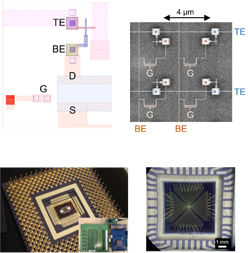24.07.2025Open Position MEP/BEP
Open position MEP: Design and fabrication of 1T1R (1 transistor 1 ReRAM) crossbars for neuromorphic computing
Ryoichi Ishihara
Associate Professor, Group leader
Qutech, Dep. Quantum and Computer Engineering, Faculty of Electrical Engineering, Mathematics and Computer Science, Delft University of Technology
Ishihara-lab focuses on the integration technologies for unconventional electronic systems; quantum computers, quantum sensors, neuromorphic computers, and biodegradable sensors. Our work involves new materials, scalable fabrication of electronic and photonic devices, and 3D heterogeneous integration, aiming to realize unconventional electronic systems.
Design and fabrication of 1T1R (1 transistor 1 ReRAM) crossbars for neuromorphic computing
Compared with computers, the human brain is incredibly energy efficient . Scientists are therefore drawing on how the brain and its interconnected neurons function for inspiration in designing innovative computing technologies. They foresee that these brain-inspired computing systems, will be more energy efficient than conventional ones, as well as better at performing machine-learning tasks. Artificial neurons which can merge data storage and processing in a single electrical component, that is, the memristor, with good CMOS compatibility, have been anticipated that this will enable higher efficiency as the conventional computers moving data from the processor to the storage consume high energy. We are currently developing new materials for memristors and 1T1R crossbar arrays for Machine learning. One transistor one memristor(s) (1T1R) and Complimentary Resistive Switching devices can solve the chronic sneak path current problem in the existing memristor passive crossbar arrays and thus results in higher reliability, whose research and development contributes to the advancement of the field, to assess the potential applications of neuromorphic technology.

1T1R structure and Fully integrated memristor/CMOS chip and transistor-free memristors crossbars [1] [2].
References:
- M. Prezioso, et al., “Training andoperation of an integrated neuromorphic network based on metal-oxide memristors,” Nature, vol. 521, no. 7550, 2015, pp. 61-64; DOI 10.1038/nature14441.
- F. Cai, et al., “A fully integrated reprogrammable memristor–CMOS system for efficient multiply–accumulate operations,” Nature Electronics, vol. 2, no. 7, 2019, pp. 290-299; DOI 10.1038/s41928-019-0270-x.